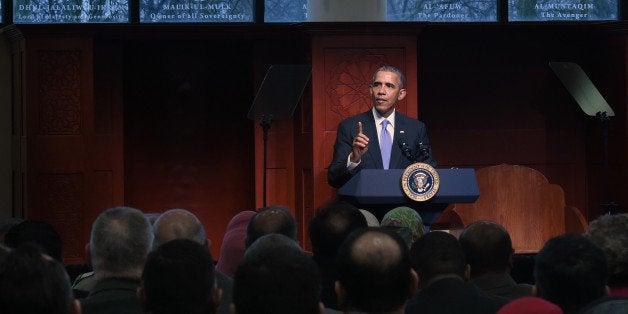
"As Muslim Americans...your entire community so often is targeted or blamed for the violent acts of the very few....No surprise, then, that threats and harassment of Muslim Americans have surged. Here at this mosque, twice last year, threats were made against your children. Around the country, women wearing the hijab...have been targeted."
-- President Barack Obama, February 3, 2016, Islamic Society of Baltimore
President Obama made headlines last month when he made his first visit to a mosque and spoke in support of the Muslim community. He made a special point to acknowledge the unique risk that Muslims in the United States face, and he specifically underscored the harassment and risk faced by Muslim women wearing headscarves. The president's speech was a strong symbol of support for the Muslim community.
But actions speak louder than words.
While the president denounced the fact that the "entire community" is often blamed for the "violent acts of a very few," military practices and law enforcement policies under his administration have inherently reinforced the notion of collective guilt and upheld a system that targets Muslim women.
A recently re-published military policy paper typifies how the president's words -- no matter how strong -- don't always align with his administration's policies and practices, especially when it comes to countering violent extremism (CVE).
As Murtaza Hussain at The Intercept explains, the paper issued by the U.S. Air Force Research Laboratory includes a section written by a self-identified former extremist Tawfik Hamid, "A Strategic Plan to Defeat Radical Islam." Hamid puts forth a collection of unproven, though familiar, theories about what causes violent extremism, including the idea that increased religiosity is a predictor of extremist violence. But he takes it a step further and says Muslim women who wear headscarves are advancing "passive terrorism."
Hamid allows that "many Muslim women are peaceful people," but, he writes, "I have observed that, over the last few decades, terrorism was preceded by an increase in the prevalence of the hijab." He also argued that sexual deprivation as a part of the "hijab phenomenon" also leads to violent extremism.
Responses to Hamid's unsupported claims were swift and sometimes hilarious. Some social media users pointed out that Muslim women are not the only ones who cover their heads. Others posted pictures of headscarf collections and sarcastically wondered which color would be the most "dangerous" to wear. A picture of a "passive terrorist" cat in a pink headscarf even made the rounds.
But Hamid's musings -- and the military's recognition of them as sound advice -- are far from funny.
The Air Force turned to Hamid for help "identifying at risk populations" and "to develop appropriate strategies for countering or defeating violent extremism." The spectacular clash of Islamophobia and misogyny in the chapter didn't prevent the military from publishing it -- twice.
Again, Muslim women are at once blamed for the existence of extremist violence and targeted by it.
In recent years, there has been some discussion about the role of women in developing CVE programs. Do we, as Muslim women, especially Muslim mothers, have a special or inherent responsibility to prevent terrorism? Or, as others have argued, are Muslim women being used to to advance a motherhood trope that unfairly holds us accountable for failings in the communities they're expected to care for?
As these questions are posed and debated, Hamid's paper demonstrates how Muslim women's behavior, dress, or actions -- or our mere presence -- are blamed for violent extremism.
Much has been said about the interpersonal harassment and violence directed toward Muslims, people believed to be Muslim, and Muslim women in particular. Women who wear headscarves risk anti-Muslim attacks in rising rates in the United States across Europe. It makes sense: We are easy to spot and, similar to a lot of gender-based violence, attackers assume we won't fight back.
But the focus on interpersonal harassment and hate violence alone ignores how the government helps creates the environment that fuels anti-Muslim hostility. This focus also obscures the ways that programs like CVE in its current form institutionalize anti-Muslim discrimination.
CVE sets out to identify and then police behaviors and even thoughts that might lead to violent extremism. The programs are often aimed at educators and students, and teach them to identify changes in political attitudes, more frequent trips to the mosque, new facial hair, and, apparently, headscarves, as signs of a potential problem. Is it any wonder, then, that anti-Muslim bullying in schools is on the rise? Or that attacks against Muslim women in headscarves and Sikh men in turbans continue to happen?
There is still a lot we don't know about CVE programs, which is why at least two lawsuits have been filed to find out more. But what we do know is disturbing, and this re-released paper certainly doesn't help quell concerns about threats to civil liberties and constitutional rights.
In Hamid's world, passive terrorism exists when people "do not conduct terrorist attacks," but "fail to denounce them," becoming a threat to "free societies."
But to help foster a truly free society, it is time government drop biased training resources, disclose more information about current CVE programs, and make Obama's words actually ring true.